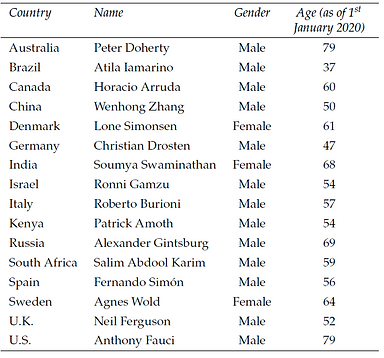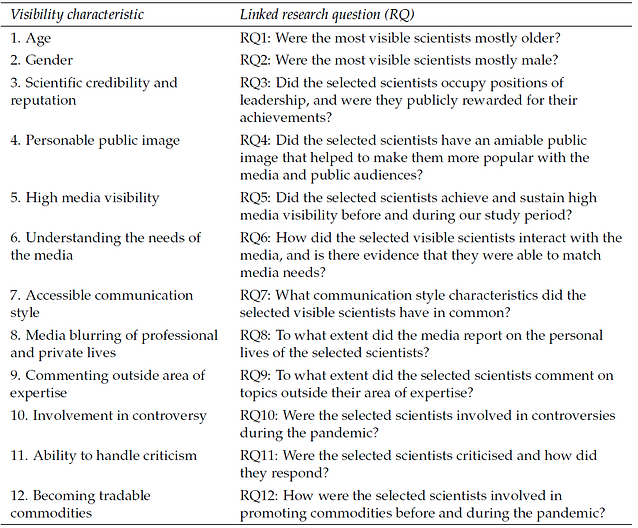Unraveling the Characteristics of Prominent Scientists during the COVID-19 Pandemic
By Rebecca Dang
Title: ‘Pandem-icons’ — exploring the characteristics of highly visible scientists during the Covid-19 pandemic
Author(s) and Year: Marina Joubert et al., , 2023
Journal: Journal of Science Communication [Open Access]
TL;DR: Popular scientists across the world possess characteristics such as effective communication and building trust to disseminate information. The study revealed that the traits held by visible scientists remained unaffected by the pandemic. The emergence of highly visible and influential scientists, known as “pandem-icons,” during the COVID-19 pandemic has shown that there are consistent traits that continuously captivate audiences’ attention.
Why I chose this paper: Many people were actively looking to scientists for answers about COVID-19 in the media during the pandemic. I noticed that there were always a handful of the same famous scientists appearing in the media such as Dr. Anthony Fauci. I am curious to see if there were specific traits that scientists had that made them more visible in the media.
Background
Earlier this month, the World Health Organization (WHO) announced that the COVID-19 pandemic was no longer a public health emergency. After 1,191 days, the world is starting to see a calming of the global health emergency that disrupted the entire world. The pandemic impacted the entire world and heightened everyone’s interest in scientific expertise.
Thus, COVID-19 presented a unique chance to examine how scientists’ public visibility varied across numerous countries. Public visibility refers to the recognition and familiarity that a scientist has among individuals outside of the scientific community. The term ‘visibility’ and ‘celebrity’ are not interchangeable and there is ongoing debate about the differences. Bucchi (2015) distinguishes that highly visible scientists may not necessarily be considered celebrity scientists because celebrities are integrated into popular culture as well.
Joubert et al., summarized 12 common traits from various previous studies that made scientists popular. They noticed that if a scientist has any of the following traits, then they tend to be more visible in the media.
- Older
- Male
- Highly esteemed
- Personable public image
- High media profile
- Aware of the media needs
- Accessible communication style
- Integrate their private life
- Wide expertise
- Controversial
- Able to handle criticism
- Participate in promotional purposes
However, Joubert et al., noted that these previous studies were always limited to a singular specific country such as the United States. In an effort to understand common traits for visible scientists across 16 countries, Joubert et al. examined these 12 traits to identify similarities and differences between popular scientists during the pandemic.
Method
This study focuses on comparing the traits of 16 popular scientists from 16 different countries. The profiles of prominent scientists were examined to help better understand their traits. The most popular scientist during January 2020 to December 2020 from each country was selected for analysis, Joubert et al., compiled a list of popular scientists using media diaries, Google Trends and Factiva for each country. Then, they collectively discussed in a group which one scientist was the most popular. The final list and associated demographics can be seen in Figure 1.

The authors used media searches including social media, articles, and photographs from the scientists to assess the visibility characteristic. Figure 2 lists the research questions that corresponded to each trait.

Findings
Despite the unprecedented circumstances arising from the pandemic, the attributes that contribute to the popularity of scientists remain consistent. The most visible scientists during this period shared at least 8 out of the 12 previously commonly identified characteristics held by visible scientists. The faces of science during the pandemic was nothing groundbreaking as the majority of popular scientists were still: 1) older, 2) male, 3) highly esteemed, 4) have a personable image, 5) high media profile, 6) have an accessible communication style, 7) shared their private life, and 8) controversial were exhibited in most of the popular scientists.
Joubert et al., found a slight difference in traits related to the awareness of media needs, handling criticism, and promotional participation. First, related to awareness of media needs, 3 out of the 16 scientists were not active on social media. Secondly, only 8 of the scientists experienced criticism during the study. Thirdly, it should be noted that not all of the popular scientists engaged in promotional activities.
Furthermore, nearly all of the scientists in the study limited their comments to their respective areas of expertise. This finding deviated from previous research, which showed that popular scientists often ventured into commenting beyond their specialized fields.
Takeaway
The study confirms that visibility is influenced by factors such as gender, media skills, willingness to engage with the public, ability to respond to criticism, and coping with controversy. Consequently, scientists who possess these traits may have the privilege of experiencing greater popularity and recognition.
Science communicators must be mindful of the traits they endorse and the perception of science they convey to the public. It is important for science communications to avoid perpetuating stereotypes and instead strive to uplift underrepresented voices and ensure equitable visibility. Science communicators trainers can support scientists in developing the skills to respond constructively to criticism, counter misinformation, and navigate controversy with scientific integrity.
Edited by: Scout Barker and Niveen AbiGhannam.
Cover image credit: Austin Distel from Unsplash.

